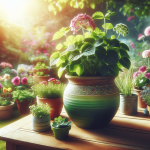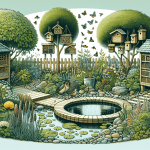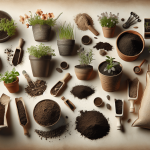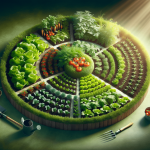This post may contain affiliate links. As an Amazon Associate, we may earn commissions from qualifying purchases.
If you’ve ever found yourself wondering how to tackle the challenge of managing and improving drainage in your garden, then you’re in the right place. This guide is crafted to offer you insights and practical advice on creating a garden that not only thrives but is also well-equipped to handle excess water. Whether you’re dealing with a soggy garden after a downpour or striving for healthier plant growth, understanding the essentials of good drainage can transform your gardening experience. Let’s embark on this journey together, and discover how to ensure your garden remains luscious, vibrant, and, most importantly, properly drained.
How Do I Manage and Improve Drainage in My Garden?
Gardening is a rewarding endeavor, but it does come with its share of challenges, with poor drainage being near the top of the list. Whether you’re dealing with waterlogged soil after rainstorms or dry, cracked earth, managing and improving the drainage in your garden is key to ensuring your plants thrive. Let’s dive into understanding garden drainage, assessing your garden’s current situation, and implementing solutions to keep your garden healthy and happy.
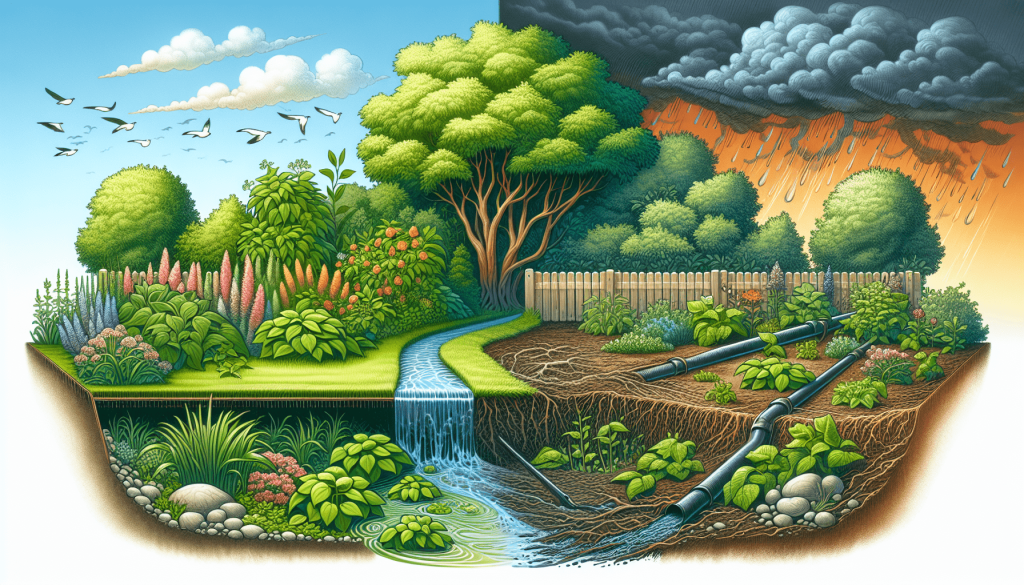
Understanding Garden Drainage
Before you start digging or making changes to your garden, it’s crucial to understand the basics of garden drainage and how various factors affect it.
Types of Soil and Their Drainage Capabilities
Different types of soil have different drainage capabilities. Sandy soil, for instance, drains quickly but doesn’t hold nutrients well. Clay soil holds water and nutrients much longer but drainage can be very slow, leading to waterlog issues. Loamy soil, a balanced mix of sand, silt, and clay, is ideal for most gardens due to its balanced drainage capabilities.
Signs of Poor Drainage in Your Garden
Recognizing the signs of poor drainage is the first step towards solving the problem. Signs include water pooling on the surface after rain, soil remaining soggy for days, stunted plant growth, and even the appearance of mold or mildew.
How Landscape Affects Water Flow
Your garden’s landscape plays a significant role in water drainage. Natural slopes and dips can either help or hinder water flow. Understanding the natural flow of water in your garden is essential for addressing drainage issues effectively.
Assessing Your Garden’s Drainage
A systematic assessment can provide insights into your garden’s specific drainage needs.
Conducting a Simple Soil Drainage Test
You can perform a simple test to evaluate your soil’s drainage by digging a hole, filling it with water, and observing how long it takes for the water to drain away. This test helps in understanding your soil’s current condition.
Identifying Low Spots and Water Collection Areas
Take a walk around your garden after rain and note any areas where water seems to collect or pool. These spots are prime candidates for drainage improvement efforts.
Evaluating the Impact of Existing Vegetation on Drainage
Plants, trees, and other vegetation significantly affect drainage, both positively and negatively. Some plants can help by absorbing excess water, while others might worsen the drainage by blocking natural paths of runoff.
Improving Soil Structure
Enhancing your soil’s structure is a foundational step in improving drainage.
Adding Organic Matter to Enhance Soil Permeability
Incorporating organic matter like compost or well-rotted manure can greatly improve soil structure and permeability, especially for clay-heavy soils.
The Role of Compost in Improving Drainage
Compost not only improves soil structure but also adds essential nutrients. Regularly adding compost is a key strategy in creating a more drain-friendly garden.
Using Sand to Aid in Drainage for Clay-Heavy Soils
Mixing sand into clay-heavy soils can help break up the dense structure and improve water flow. However, it’s important to balance the mixture to avoid creating a cement-like soil texture.
Creating a Proper Slope
Grading your garden correctly can significantly impact its drainage capabilities.
Grading Your Garden for Optimized Water Flow
Creating a gentle slope away from your house and garden beds allows water to drain more effectively, preventing pooling and saturation.
Strategies for Leveling and Sloping Without Heavy Machinery
With planning and a bit of elbow grease, you can manually level and slope your garden using simple tools like shovels and rakes.
Dealing with Sloped Gardens to Prevent Erosion
In gardens with natural slopes, implementing terraces or planting ground-cover plants can help prevent soil erosion while improving drainage.
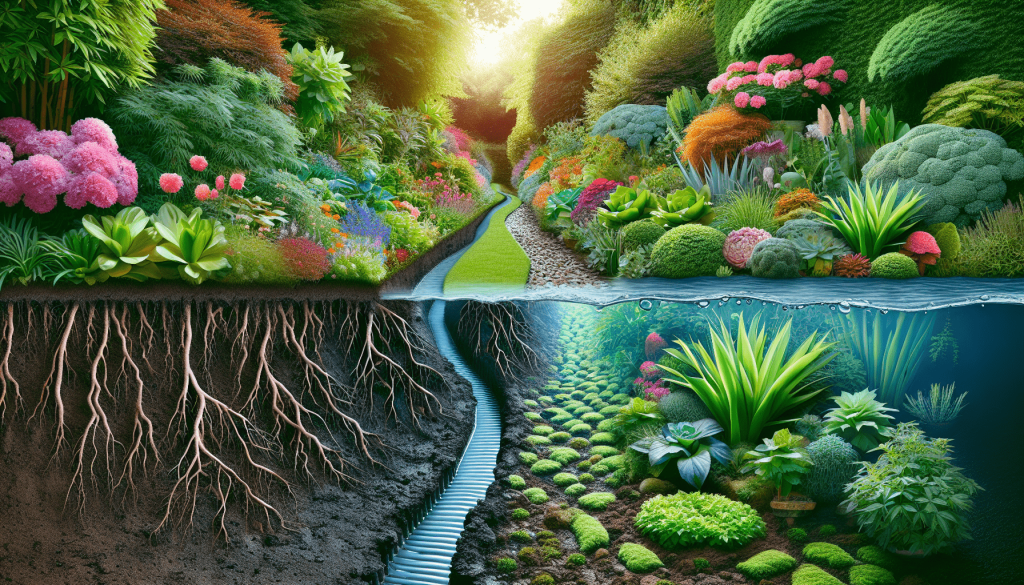
Installing Drainage Solutions
Sometimes, more direct drainage solutions are necessary to properly manage water flow.
Types of Drainage Systems (French Drains, Swales, etc.)
French drains, swales, and dry wells are effective drainage solutions for redirecting water away from problematic areas.
Steps for Installing a French Drain
Installing a French drain involves digging a trench, laying a perforated pipe, and filling it with gravel. This system redirects water underground, preventing surface level waterlogging.
Incorporating Dry Wells for Difficult Drainage Areas
Dry wells provide a place for excess water to collect and slowly infiltrate back into the soil, ideal for areas where surface drainage is not sufficient.
Using Plants to Improve Drainage
Selectively planting certain types of vegetation can naturally enhance your garden’s drainage.
Selecting Water-Loving Plants for Wet Areas
Water-loving plants can soak up excess moisture and beautify soggy spots in the garden.
Creating Rain Gardens to Solve Drainage Problems
Rain gardens are designed to catch runoff water, allowing it to slowly permeate back into the ground, effectively solving minor drainage issues.
How Deep-Rooted Plants Can Help
Deep-rooted plants can help break up dense soil, allowing for better water filtration and movement within the soil.
Maintaining Your Drainage System
Ongoing maintenance is crucial for keeping your drainage system functional.
Regular Checks and Cleaning of Drainage Systems
Inspecting and cleaning out your drainage systems ensures they remain unblocked and effective.
Dealing with Blockages and Repairs
Promptly addressing any blockages or necessary repairs prevents minor issues from becoming major headaches.
The Role of Guttering and Downspouts in Garden Drainage
Well-maintained guttering and downspouts play a critical role in directing roof runoff water away from your garden and foundation.
Mulching to Improve Drainage
Mulch can significantly impact your garden’s moisture levels and overall health.
Choosing the Right Type of Mulch
Opt for mulches that complement your garden’s needs—organic mulches improve soil structure over time, aiding in drainage.
How Mulch Affects Soil Moisture and Permeability
Mulch helps retain soil moisture during dry spells and allows rainwater to infiltrate more evenly during wetter periods.
Applying Mulch to Reduce Surface Compaction
A generous layer of mulch can also prevent soil compaction, helping maintain an open soil structure that fosters better drainage.
Adapting Irrigation Practices
Optimizing how you water can also play a role in managing drainage.
Using Drip Irrigation for Efficient Watering
Drip irrigation delivers water directly to the plant roots, minimizing runoff and ensuring water goes exactly where it’s needed.
Adjusting Watering Schedules Based on Soil Drainage
Monitor your garden’s moisture levels and adjust watering schedules to prevent overwatering, a common cause of poor drainage.
The Benefits of Soaker Hoses and Their Impact on Drainage
Soaker hoses gently water gardens, promoting deep watering that supports better soil structure and drainage.
Innovative Solutions for Managing Drainage
Staying informed about the latest drainage solutions can provide new ways to manage water in your garden effectively.
Exploring Green Infrastructure Options
Rain barrels, green roofs, and permeable paving are innovative ways to manage runoff and improve garden drainage.
The Role of Technology in Monitoring and Improving Garden Drainage
Smart irrigation systems and soil moisture sensors can help maintain the ideal moisture balance in your garden.
Case Studies of Effective Drainage Management in Gardens
Learning from successful drainage projects can inspire and guide improvements in your own garden.
In conclusion, managing and improving drainage in your garden might seem daunting at first, but by understanding your garden’s specific needs, systematically assessing drainage issues, and implementing targeted solutions, you can create a thriving garden that withstands the challenges of too much—or too little—water. Remember, a well-drained garden is a happy garden.


